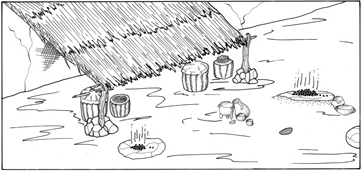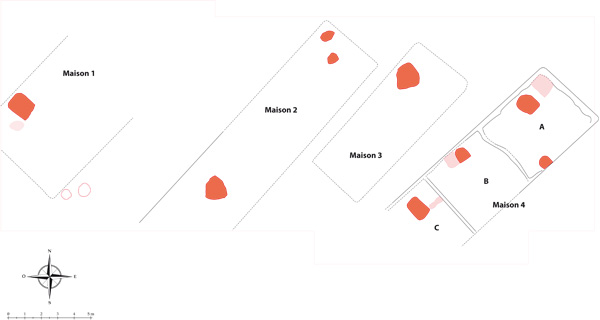Neolithic: Organisation of the settlement
The settlement of the Late Neolithic I period, which lasted four or five centuries (c. 5200-4800 BC) and produced layers with a total thickness of approximately 5m, extended over a large area but still covered only part of the present tell ’s surface. Our knowledge about its layout remains fragmentary, but the alignments of postholes, the orientation of the collapsed earth masses and of the rare still-standing walls, as well as the distribution of the archaeological remains, all suggest a North-East/South-West axis, probably corresponding to one side of the rooms.
 Between the houses there were walkways or roads for circulation. In the western part of sector V, two concentrations of stones and sherds laid on the floor and separated by an empty space could correspond to such a passage. In the eastern part of the same sector, the comparative study of the various remains allowed the reconstruction of a real courtyard measuring at least 30 m2, one side of which could have been protected by a canopy. Some domestic activities (storage, food preparation) obviously took place in this space.
Between the houses there were walkways or roads for circulation. In the western part of sector V, two concentrations of stones and sherds laid on the floor and separated by an empty space could correspond to such a passage. In the eastern part of the same sector, the comparative study of the various remains allowed the reconstruction of a real courtyard measuring at least 30 m2, one side of which could have been protected by a canopy. Some domestic activities (storage, food preparation) obviously took place in this space.
The Late Neolithic II settlement lasted almost as long (roughly between 4700 and 4300/4200 BC) but the related deposits are thinner (2 to 4 m). The extent of the settlement, however, seems to be greater: evidence of this expansion has been discovered in sector 2, on the south side of the tell, but it is possible that it affected other sides as well. The layout of the settlement is much better known for this period.

In Sector 6, we have a series of very clear ground plans, from houses arranged in parallel rows along a Northeast-Southwest axis and separated by walkways. This kind of organisation is also attested in other contemporary sites in the Balkans (e.g., Karanovo and Poljanitsa).

